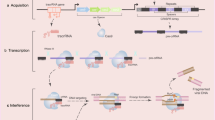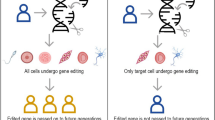Abstract
The recombination activating genes RAG-1 and RAG-2 are adjacent genes that act synergistically to activate variable-diversity-joining (V(D)J) recombination. Southern analysis of hybrid cell lines derived from patients with the Wilms tumor-aniridia-genitourinary defects-mental retardation (WAGR) syndrome and from mutagenized cell hybrids selected for deletions in chromosome 11 has allowed us to map the chromosomal location of the human RAG locus. The RAG locus defines a new interval of human chromosome 11p, but is not associated with any genetically mapped human disease. Guided by the chromosomal localization of the human recombination activating genes, we have also mapped the location of the mouse Rag locus.
Similar content being viewed by others
References
Blackwell, T. K. and Alt, F. W.: Immunoglobulin Genes. In B. D. Hames and D. M. Glover (eds.): Molecular Immunology, pp. 1–60, IRL Press, Washington DC, 1988
Bosma, G. C., Custer, R. P., and Bosma, M. J.: A severe combined immunodeficiency mutation in the mouse. Nature 301: 527–530, 1983
Bosma, G. C., Davisson, M. T., Ruetsch, N. R., Sweet, H. O., Shultz, L. D., and Bosma, M. J.: The mouse mutation severe combined immune deficiency (scid) is on chromosome 16. Immunogenetics 29: 54–57, 1989
Brilliant, M. H., Szabo, G., Katarova, Z., Kozak, C. A., Glaser, T. M., Greenspan, R. J., and Housman, D. E.: Sequences homologous to glutamic acid decoarboxylase cDNA are present on mouse chromosomes 2 and 10. Genomics 6: 115–122, 1990
Carlson, L. M., Oettinger, M. A., Schatz, D. G., Mastellar, E. L., Hurley, E., McCormack, W., Baltimore, D., and Thompson, C. B.: Selective expression of RAG-2 in chicken B cells undergoing immunoglobulin gene conversion. Cell 64: 201–208, 1991
Davis, M. M.: T-cell antigen receptor genes. In B. D. Hames and D. M. Glover (eds.): Molecular Immunology. IRL Press, Washington DC, 1988
Feinberg, A. P. and Vogelstein, B.: A technique for radiolabeling DNA restriction fragments to high specific activity. Anal Biochem 132: 6–13, 1983
Francke, U., Homes, L. B., Atkins, L., and Riccardi, V. M.: WAGR denotes Wilms tumor (W), aniridia (A), genitourinary anomalies (G), and mental retardation (R). Cytogenet Cell Genet 24: 185, 1979
Glaser, T., Lewis, W. H., Bruns, G. A. P., Watkins, P. C., Rogler, C. E., Shows, T. B., Powers, V. E., Willard, H. F., Goguen, J. M., Simola, K. O. J., and Housman, D. E.: The subunit of follicle-stimulating hormone is deleted in patients with aniridia and Wilms' tumour, allowing a further definition of the WAGR locus. Nature 321: 882–887, 1986
Glaser, T., Housman, D., Lewis, W. H., Gerhard, D., and Jones, C.: A finestructure deletion map of human chromosome 11p: Analysis of J1 series hybrids. Somat Cell Mol Genet 15: 477–501, 1989
Glaser, T., Lane, J., and Housman, D.: A mouse model of the Aniridia-Wilms tumor deletion syndrome. Science 250: 823–827, 1990
Kao, F., Jones, C., and Puck, T. T.: Genetics of somatic mammalian cells: Genetic, immunologic, and biochemical analysis with Chinese hamster cell hybrids containing selected human chromosomes. Proc Natl Acad Sci USA 73: 193–197, 1976
Lugo, T. G., Handelin, B., Killary, A. M., Housman, D. E., and Fournier, R. E. K.: Isolation of microcell hybrid clones containing retroviral vector insertions into specific human chromosomes. Mol Cell Biol 7: 2814–2820, 1987
Oettinger, M. A., Schatz, D. G., Gorka, C., and Baltimore, D.: RAG-1 and RAG-2, adjacent genes that synergistically activate V(D)J recombination. Science 248: 1517–1523, 1990
Schatz, D. G., Oettinger, M. A., and Baltimore, D.: The V(D)J recombination activating gene (RAG-1). Cell 59: 1035–1048, 1989
Schuler, W., Weiler, I. J., Schuler, A., Phillips, R. A., Rosenberg, N., Mak, T. K., Kearney, J. F., Perry, R. P., and Bosma, M. J.: Rearrangement of antigen receptor genes is defective in mice with severe combined immune deficiency. Cell 46: 963–972, 1986
Author information
Authors and Affiliations
Rights and permissions
About this article
Cite this article
Oettinger, M.A., Stanger, B., Schatz, D.G. et al. The recombination activating genes, RAG 1 and RAG 2, are on chromosome 11p in humans and chromosome 2p in mice. Immunogenetics 35, 97–101 (1992). https://doi.org/10.1007/BF00189518
Received:
Revised:
Issue Date:
DOI: https://doi.org/10.1007/BF00189518




